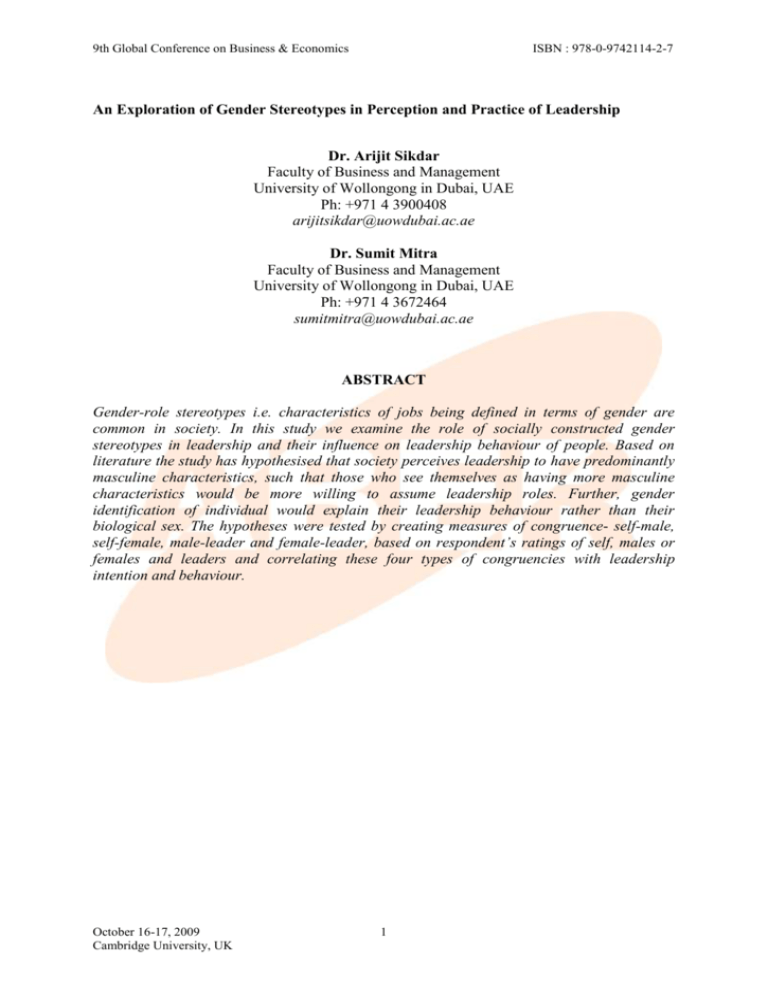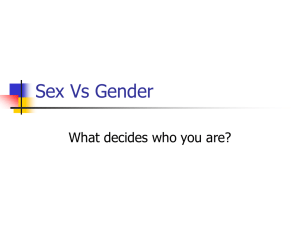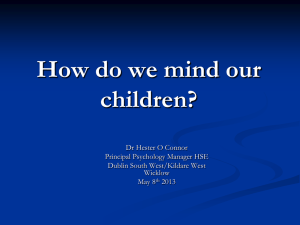An Exploration of Gender Stereotypes in Perception and Practice of
advertisement

9th Global Conference on Business & Economics ISBN : 978-0-9742114-2-7 An Exploration of Gender Stereotypes in Perception and Practice of Leadership Dr. Arijit Sikdar Faculty of Business and Management University of Wollongong in Dubai, UAE Ph: +971 4 3900408 arijitsikdar@uowdubai.ac.ae Dr. Sumit Mitra Faculty of Business and Management University of Wollongong in Dubai, UAE Ph: +971 4 3672464 sumitmitra@uowdubai.ac.ae ABSTRACT Gender-role stereotypes i.e. characteristics of jobs being defined in terms of gender are common in society. In this study we examine the role of socially constructed gender stereotypes in leadership and their influence on leadership behaviour of people. Based on literature the study has hypothesised that society perceives leadership to have predominantly masculine characteristics, such that those who see themselves as having more masculine characteristics would be more willing to assume leadership roles. Further, gender identification of individual would explain their leadership behaviour rather than their biological sex. The hypotheses were tested by creating measures of congruence- self-male, self-female, male-leader and female-leader, based on respondent’s ratings of self, males or females and leaders and correlating these four types of congruencies with leadership intention and behaviour. October 16-17, 2009 Cambridge University, UK 1 9th Global Conference on Business & Economics ISBN : 978-0-9742114-2-7 INTRODUCTION Gender stereotypes are generalized beliefs about the characteristics and qualities attributed to men and women in society (Eagly, 1987). Gender is distinct from sex as sex is ascribed to biology, anatomy, hormones, and physiology and gender as constructed through social, cultural, and psychological means (West & Zimmerman, 1987). In general, men are characterized as aggressive, risk-taking, decisive, and autonomous (agentic attributes), whereas women are characterized as kind, caring, relational, and humble (communal attributes) which translates into gender stereotypes of male and female. Expectations and beliefs concerning the qualities that men and women have often dictate the type of jobs that are considered appropriate for them, leading to a situation in which the requisite characteristics for some jobs are defined in terms of gender, such as ‘men’s work or women’s work’ (Heilman, 1997). For example, we hear more often about “male mechanics” and “female kindergarten teachers” than vice versa as gender stereotyping reinforces the belief that kindergarten teachers require characteristics associated more with women, than with men. In the organizational literature, evidence suggests that gender stereotyping is present as on qualities believed to be necessary to succeed in business, women are generally seen as inferior to men (Marlow, 2002). It has also been reported that there is gender bias with regard to the assessment of leadership in organizations (Alimo-Metcalfe, 1993). Hence it is relevant to ask how gender stereotyping is playing a role in the assessment of leadership roles in organizations. Though leadership is a widely researched topic in organizational literature, surprisingly there is lack of research to suggest whether perception of leadership from the gender angle influences leadership roles in organizations. This study is being proposed to be undertaken to fill this gap. THEORETICAL BACKGROUND AND HYPOTHESIS Gender-role Stereotype of Leadership Gender-role stereotypes i.e. the gender typing of jobs as predominantly masculine or feminine is common in society and is encouraged through socialization during childhood and adolescence, by parents, schools, peers, and the mass media, such that men and women learn at an early age that gender is associated with some tasks and not with others (Miller & Budd, 1999). The study of history in schools is replete with stories of kings rather than queens. Across the world, political leadership is seen to be dominated more by men than women. Even in the field of business, leadership role models are built around men like Jack Welch, Carlos Ghosn, Bill Gates, etc. Leadership being an abstract concept, perception of society plays an important role in the way leadership is seen and defined. The greater number and visibility of male leaders in all walks of life would have led to socialization in society that leadership role is associated with characteristics that is more masculine than feminine. This may be true, as research suggest that entrepreneurship (leadership in starting new business) is seen to be predominantly associated with masculine characteristics (Gupta, et al, 2009). In the organizational context, managers are seen as leaders by their subordinates and evidence confirms that managerial characteristics are considered more similar to typically masculine than feminine characteristics (Schein, 2001). Based on the above we hypothesize: October 16-17, 2009 Cambridge University, UK 2 9th Global Conference on Business & Economics ISBN : 978-0-9742114-2-7 H1: Both men and women will perceive leaders to have predominantly masculine characteristics. Gender-role stereotype and Leadership Role Heilman (1983) argued that when people perceive a lack of fit between themselves and the stereotypes associated with a particular task, they negatively evaluate their ability to engage in activities associated with that task and thus tend to reduce the likelihood of pursuing such tasks. This is true, as evidence indicates that individuals are attracted to tasks and jobs that are perceived as requiring characteristics similar to their own (Markman & Baron, 2003). Individuals identify with characteristics attributed to males or females based on gender (Schmader, 2002). Because gender is ‘done’ rather than something people ‘have’ (Bruni et al., 2004), men and women vary in the extent to which they identify with masculine or feminine characteristics, i.e. people may see themselves as more or less masculine or feminine (West & Zimmerman, 1987) and this identification influences their attitudes towards stereotyped tasks (Nosek et al., 2002). So if leadership is associated with masculine characteristics, then people who see themselves as having more masculine characteristics are likely to have higher intentions to take up leadership role as compared to people who see themselves as having less masculine characteristics. H2: There will be a positive relationship between people who see themselves as possessing masculine characteristics and their intention to take up leadership role. Leadership behaviour i.e. the way leaders engage in their activities or perform their role as a leader, and the antecedents of behaviour has been widely studied. It has been found that personal orientation of leaders is associated with patterns of leadership displayed by individuals (Bass & Dunteman, 1963). Evidence suggests that individuals with more empathic personalities tend to display more considerate leadership behaviour (Fleishman & Salter, 1963). As indicated earlier, individuals are attracted to tasks and jobs that are perceived as requiring characteristics similar to their own, and thus leaders would try to display leadership behaviour that is perceived as similar to their own characteristics. Leadership literature has identified different styles of leadership based on leader’s orientation towards task and people (Blake & Mouton, 1978). Transactional leadership behaviour is associated with the leader being more task oriented and with low consideration towards people. Transactional leadership is characterised by behaviour associated more with the “agentic attributes” of masculine gender. While, transformational leadership behaviour is associated with the leader having high consideration for people. Transformational leadership is characterised by behaviour focusing on relationship and consideration for people and is associated with the “communal attributes” of feminine gender. It is also perceived that women have different leadership styles than men (Johnson, 1976), indicating that gender characteristics impact on leadership behaviour, as women are generally seen as representing the feminine gender. Thus it could be argued, that leadership behaviour would be influenced by the gender identification i.e. how individuals identify with characteristics attributed to males or females based on gender. People who see themselves as having more masculine characteristics are likely to exhibit the transactional leadership behaviour while people who see themselves as having more feminine characteristics are likely to exhibit the transformational leadership behaviour. October 16-17, 2009 Cambridge University, UK 3 9th Global Conference on Business & Economics ISBN : 978-0-9742114-2-7 H3a: There will be a positive relationship between people who see themselves as possessing masculine characteristics and their intention to follow transactional leadership role. H3b: There will be a positive relationship between people who see themselves as possessing feminine characteristics and their intention to follow transformational leadership role. FINDINGS Procedure Data was collected from participants who were familiar with the concept of leadership. To operationalise this, it was ensured that all participants of the study were undergoing or had undergone business management courses and had prior work experience. Data was collected in two time periods spaced by an interval of 2-3 weeks. In Period 1, respondents were asked to complete the Schein Descriptive Index (SDI) for leaders (what you think leaders are like) and another SDI for male or female (what you male or female are like). The SDI for male or female was distributed randomly irrespective of the sex of the respondent. In period 2, respondents were asked to complete SDI on self (what you think you are like) and Leadership Behaviour survey. SDI consisted of 92 descriptive items consisting of single word adjectives (e.g. helpful, shy, etc.) and phrases (high need for power, etc.) and has been used extensively in gender stereotype measurement (Schien, 1973 & 2001; Brenner et al, 1989). Respondents were asked to rate the descriptive terms on a 5-point scale ranging from 1- not characteristic to 5characteristic, with a neutral rating of 3- neither characteristic nor uncharacteristic. Leadership style survey consisted of 28 items related to questions on intentions and styles of leadership behaviour favoured by the respondent. These questions were developed based on similar instruments used to measure leadership style. Each question was required to be rated on a 5-point scale ranging from 1- not characteristic to 5- characteristic, with a neutral rating of 3- neither characteristic nor uncharacteristic. Results and Analysis Completed SDI for leader characteristics was returned by 88 respondents out of which 48 were male and 40 were female respondents. Completed SDI for male characteristics was collected from 44 respondents out of which were 26 male and 18 female. Similarly, completed SDI for female characteristics was collected from 43 respondents, the break- up of which was 21 male and 22 female. Seventy seven respondents returned completed SDI on self and the leadership behaviour survey. Each of the descriptive 92 items of the SDI was considered as a class and within each class the mean ratings for leader, male and female were calculated. Then the intraclass correlation (ICC) between the mean ratings of the typical leader, typical male and typical female were calculated. ICC is considered useful when the data is not independent and interrelated (Cook, 2000). The results are shown in Table 1. October 16-17, 2009 Cambridge University, UK 4 9th Global Conference on Business & Economics ISBN : 978-0-9742114-2-7 Table 1: Correlations Constructs 1. Male 2. Female 3. Leader 4. Self-Male Congruence 5. Self-Female Congruence 6. Leadership Intention 7. Task Orientation 8. People Orientation N 44 43 88 77 1 2 3 0.177 0.732** 0.411** - 4 5 6 7 8 - 77 - 77 0.4752** -0.1012 77 0.341** 0.229 77 0.143 -0.0458 - Firstly, the ICC between mean ratings of typical male and typical female showed nonsignificant correlation (r=0.177, ns, n= 92 items) which established that the typical male and typical female as constructs are independent. This finding is also in consonance with the existing literature wherein gender based differences have been reported (Powell & Graves, 2003). This established the robustness and independence of the male and female constructs. The correlation between ratings of leader and male (r= 0.732, p<0.01, n=92 items) was significant and greater than the correlation between ratings of leader and female (r= 0.411, p<0.01, n=92 items). This supports the first hypothesis that leaders in general would be perceived to have predominantly masculine characteristics. However, the correlation between ratings of leader and female was significant which shows that leaders are also perceived to possess feminine characteristics. This finding is interesting as similar studies in the past on managers (Brenner et al 1989) and entrepreneurs (Gupta et al, 2009) have shown that ratings of managers and entrepreneurs have zero or near zero correlation with ratings of female while correlation with ratings of male have been at similar level. Thus it could be concluded that as compared to managers or entrepreneurs, leaders are perceived to possess more characteristics as common to women. To test hypothesis 2, wherein greater an individual’s perception of self with males the greater would the intention to take up leadership role, congruence between an individual’s perception of self and males (S-M congruence) and an individual’s perception of self and females (S-F congruence) were calculated. Intention to take up leadership role was calculated for the items in the leadership intention and behaviour questionnaire. Partial correlation coefficient between S-M congruence and leadership intention while controlling for S-F congruence, age and function is significant (r =0.4752, p< 0.01) was significant while partial correlation between S-F congruence and leadership intention while controlling for S-M congruence, age and function is non-significant (r =-0.1012, ns) and. This supports hypothesis 2 that greater an individual’s perception of self with males the greater would the intention to take up leadership role. Hypothesis 3 stated that greater an individual’s perception of self with males the greater would be the intention to follow task-oriented leadership style while greater an individual’s perception of self with females the greater would be the intention to follow people-oriented leadership style. To test the hypothesis, response to leadership style questionnaire was scored to develop score of people orientation and task orientation for each respondent. Then October 16-17, 2009 Cambridge University, UK 5 9th Global Conference on Business & Economics ISBN : 978-0-9742114-2-7 correlation was run between S-M congruence and task orientation while controlling for S-F congruence, age and function and which was significant (r= 0.341, p< 0.01). Correlation was also carried out between S-M congruence and people orientation while controlling for S-F congruence, age and function and which was non-significant(r= 0.143, ns). Thus the results support the hypothesis that greater an individual’s perception of self with males the greater would be the intention to follow task-oriented leadership style. Similarly, correlation was calculated between S-F congruence and task orientation while controlling for S-M congruence, age and function and which was non-significant (r=0.229, ns). While correlation between S-F congruence and people orientation while controlling for S-M congruence, age and function was also non-significant (r= -0.0458, ns). Thus the results do not support the hypothesis that greater an individual’s perception of self with females the greater would be the intention to follow people-oriented leadership style. This result was confounding as it was expected that greater influence of female characteristics would lead to higher people oriented leadership style. So each individual’s S-M and S-F congruence measures were analysed to find out whether S-F congruence measure was greater than S-M congruence measure. Also each individual’s leadership style score on people orientation and task orientation was compared to find out whether people orientation was greater than task orientation. The results are displayed in Table 2. The results show that respondent’s with higher S-F congruence than S-M congruence would be more likely to have higher people orientation score than task orientation score. This lends support to the fact that the presence of S-F congruence influences the people orientation aspect of the leadership style. Table 2: Leadership Behaviour Orientation Yes S-F congruence > S-M 40 congruence People orientation score > 13 task orientation score No 38 7 CONCLUSION The above study is expected to throw light how men and women in contemporary society see gender-stereotyping of leadership. This would provide a better understanding of why the “glass ceiling” exists for women in their career advancement and what needs to be done to break the “glass ceiling”. The findings would help organization, while making the choice of leaders, to be more aware of how gender bias could lead to the exclusion of a deserving candidate leading to a loss for the organization. The finding related to gender-role stereotype and leadership behaviour would help explain why certain individuals are more than willing to assume leadership role than others. This might help organizations to differentiate between initiative-driven leaders from passive leaders. The findings might help to unravel an interesting dichotomy –why some leaders always exhibit the same behaviour even in different context and which might organizations to assess a leader’s gender profile before assignment to the task. October 16-17, 2009 Cambridge University, UK 6 9th Global Conference on Business & Economics ISBN : 978-0-9742114-2-7 REFERENCES Alimo-Metcalfe, B. (1993). Women in management; organizational socialization and assessment practices that prevent career advancement. International Journal of Selection and Assessment, 1(2), 68-83. Bass, B. M. & Dunteman, G. (1963). Behaviour in groups as a function of self interaction and task orientation. Journal of Abnormal and Social Psychology, 66(5), 419-428. Blake, R.R. & Mouton, J.S. (1978). The new managerial grid. Houston: Gulf. Brenner O. C., Tomkiewicz J., & Schein V. E. (1989). The relationship between sex role stereotypes and requisite management characteristics revisited. Academy of Management Journal, 32, 662-669. Bruni, A., Gherardi, S., & Poggio, B. (2004). Doing gender, doing entrepreneurship: An ethnographic account of intertwined practices. Gender, Work and Organization, 11, 407-429. Chatman, J. A. (1991). Matching people and organizations: Selection and socialization in public accounting firms. Administrative Science Quarterly, 36, 459-489. Cook, C. (2000). A review of intraclass correlation. Annual Meeting of the Southwest Educational Research Association, Dallas, TX, January 27-29. Duehr, E. E., & Bono, J. E. (2006). Men, women, and managers: Are stereotypes finally changing. Personnel Psychology, 59, 815-846. Eagly, A. H. (1987). Sex differences in social behavior: A social-role interpretation. Hillsdale, NJ: Erlbaum. Fleishman, E.A. & Salter, J.A. (1963). Relation between the leader’s behaviour and his empathy towards subordinates. Journal of Industrial Psychology, 7, 79-84. Gupta, V., Turban, D., Wasti, A. & Sikdar, A. (2009). The role of gender stereotypes in perceptions of entrepreneurs and intentions to become an entrepreneur. Entrepreneurship Theory and Practice. Heilman, M. E. (1983). Sex bias in work settings: The lack of fit model. Research in Organizational Behavior, 5, 269-298. Johnson, P. (1976). Women and power; towards a theory of effectiveness. Journal of Social Issues, 32 (3), 99-110. Markman, G. D., & Baron, R. A. (2003). Person-entrepreneurship fit: Why some people are more successful as entrepreneurs than others? Human Resource Management Review, 13, 281-301. Marlow, S. (2002). Women and self-employment: A part of or apart from theoretical construct? International Journal of Entrepreneurship and Innovation, 3(2), 83-91. Miller, L., & Budd, J. (1999). The development of occupational sex-role stereotypes, occupational preferences and academic subject preferences in children at ages 8, 12 and 16. Educational Psychology, 19, 17-35. Nosek, B. A., Banaji, M. R., & Greenwald, A. G. (2002). Math = male, me = female, therefore math ╪ me. Journal of Personality and Social Psychology, 83, 44-59. Powell, G. N., & Graves, L. M. (2003). Women and men in management. Thousand Oaks: Sage. Schein, V. E. (1973). The relationship between sex role stereotypes and requisite management characteristics. Journal of Applied Psychology, 57, 95-100. Schein, V. E. (2001). A global look at psychological barriers to women’s progress in management. Journal of Social Issues, 57, 675-688. Schein, V. E., Mueller, R. (1992). Sex role stereotyping and requisite management characteristics: A cross cultural look. Journal of Organizational Behavior, 13, 439-447. October 16-17, 2009 Cambridge University, UK 7 9th Global Conference on Business & Economics ISBN : 978-0-9742114-2-7 Schmader, T. (2002). Gender identification moderates stereotype threat effects on women’s math performance. Journal of Experimental Social Psychology, 38, 194-201. West, C., & Zimmerman, D. H. (1987). Doing gender. Gender and Society, 1, 125-151. October 16-17, 2009 Cambridge University, UK 8





